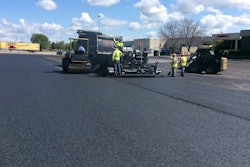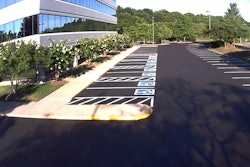The benefits of sealcoating asphalt parking lots are measured in the long term through increased useful life of the pavement resulting in reduced cost. There are other potential benefits that can best be seen through the long term, such as impacts on energy usage or environmental impacts. Life cycle analysis is a method of comparing benefits of using different methods or materials. Two life cycle analysis studies have highlighted the benefits of pavement maintenance.
The first study was presented at the First International Conference on Pavement Preservation held in 2010 in Newport Beach. One of the papers presented at this conference, Energy Usage and Greenhouse Gas Emissions of Pavement Preservation Processes for Asphalt Concrete Pavements by J. Chehovits & L. Galehouse, looked at roadway pavements with a focus on energy use and greenhouse gas (GHG) emissions of new and major repaving projects versus energy use and GHG emissions of pavement maintenance operations. The goal of pavement maintenance programs is the same for roadways and parking lots. The Chehovits & Galehouse paper describes the rationale for pavement maintenance this way:
"Use of pavement preservation treatments extends the remaining service life of asphalt concrete pavements. These treatments typically include spray applied surface seals, thin overlays, crack treatments, chip seals, slurry seal/micro surfacing, surface recycling and others. Each preservation treatment reduces damaging effects of aging and deterioration of the pavement surface layer and helps protect the integrity of the underlying pavement structure. If proactive preservation treatments are not used, pavements deteriorate more rapidly and require major rehabilitation with structural overlays or reconstruction much earlier."
The study found that significant energy and GHG emissions savings are achieved when using pavement preservation techniques. Their findings concerning energy savings were summarized as follows:
"New construction, major rehabilitation, thin HMA overlay, and HIR have the highest energy use and range from 5,000 to 10,000 BTU/yd2 per year. Chip seals, slurry seals, micro-surfacing, and crack filling utilize lower amounts of energy per year of extended pavement life and range from 1,000 to 2,500 BTU/yd2 per year. Crack seals and fog seals use the least amount of energy per year of extended pavement life at less than 1,000 BTU/yd2 per year."
The overall conclusion of the study was:
"To minimize energy use and GHG emissions over the life of a pavement, all preservation treatments should be utilized as appropriate to the maximum extent possible for the existing pavement conditions."
The second study was by D. Schechtman as part of the New York-New Jersey Harbor Study conducted by the New York Academy of Sciences. Schechtman conducted a limited life cycle analysis (LCA). Schechtman described his work as follows:
"…we have conducted a comparison of the upstream environmental impacts of refined coal-tar sealed, asphalt sealed, and unsealed concrete parking lots. This analysis is limited to estimating the “upstream” environmental impacts – only those associated with the manufacturing, and installation of parking lots."
One conclusion of the LCA was as follows:
"In assessing which lot has the lowest overall environmental impact in the upstream phase (manufacturing and installation), the result will depend on which indicator you value the most. If toxic emissions … were of the greatest concern then the asphalt lot, specifically the asphalt lot sealed with refined coal-tar based sealant, would be the best option for the upstream phase. [emphasis added]"
The difference between coal tar- and asphalt-based sealants were much smaller than the difference between those two and a concrete paved surface.
For more information on the Pavement Coatings Technology Council visit www.pavementcouncil.org.










![Lee Boy Facility 2025 17 Use[16]](https://img.forconstructionpros.com/mindful/acbm/workspaces/default/uploads/2025/09/leeboy-facility-2025-17-use16.AbONDzEzbV.jpg?ar=16%3A9&auto=format%2Ccompress&fit=crop&h=135&q=70&w=240)








